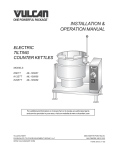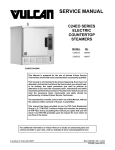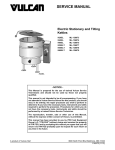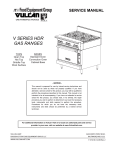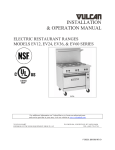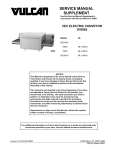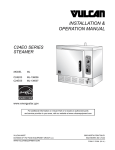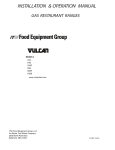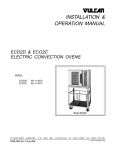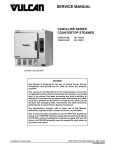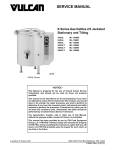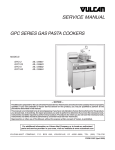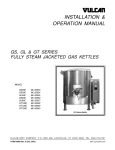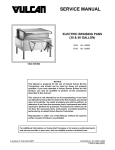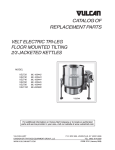Download Vulcan Materials K12ETT User's Manual
Transcript
SERVICE MANUAL ELECTRIC COUNTER TOP TILTING KETTLES K6ETT ML-136067 K12ETT ML-136068 K20ETT ML-136069 K12ETT ON STAND This Manual is prepared for the use of trained Vulcan Service Technicians and should not be used by those not properly qualified. This manual is not intended to be all encompassing. If you have not attended a Vulcan Service School for this product, you should read, in its entirety, the repair procedure you wish to perform to determine if you have the necessary tools, instruments and skills required to perform the procedure. Procedures for which you do not have the necessary tools, instruments and skills should be performed by a trained Vulcan Service Technician. Reproduction or other use of this Manual, without the express written consent of Vulcan, is prohibited. For additional information on Vulcan-Hart or to locate an authorized parts and service provider in your area, visit our website at www.vulcanhart.com. A product of VULCAN-HART LOUISVILLE, KY 40201-0696 F35496 (August 2009) ELECTRIC COUNTER TOP TILTING KETTLES TABLE OF CONTENTS GENERAL . . . . . . . . . . . . . . . . . . . . . . . . . . . . . . . . . . . . . . . . . . . . . . . . . . . . . . . . . . . . . . . . . . . . . . . . . . . . . . . . Introduction . . . . . . . . . . . . . . . . . . . . . . . . . . . . . . . . . . . . . . . . . . . . . . . . . . . . . . . . . . . . . . . . . . . . . . . . . . . . Tools . . . . . . . . . . . . . . . . . . . . . . . . . . . . . . . . . . . . . . . . . . . . . . . . . . . . . . . . . . . . . . . . . . . . . . . . . . . . . . . . . Specifications . . . . . . . . . . . . . . . . . . . . . . . . . . . . . . . . . . . . . . . . . . . . . . . . . . . . . . . . . . . . . . . . . . . . . . . . . . 3 3 3 4 REMOVAL AND REPLACEMENT OF PARTS . . . . . . . . . . . . . . . . . . . . . . . . . . . . . . . . . . . . . . . . . . . . . . . . . . . . 5 Covers and Panels . . . . . . . . . . . . . . . . . . . . . . . . . . . . . . . . . . . . . . . . . . . . . . . . . . . . . . . . . . . . . . . . . . . . . 5 Electrical Panel Components - Water Level Control, Transformer, Contactors and Temperature Control . . . 5 Bottom Components - Water Level Probe (LLCO), Temperature Sensor and Pressure Switch . . . . . . . . . . . 6 Potentiometer . . . . . . . . . . . . . . . . . . . . . . . . . . . . . . . . . . . . . . . . . . . . . . . . . . . . . . . . . . . . . . . . . . . . . . . . . . 6 Heating Element . . . . . . . . . . . . . . . . . . . . . . . . . . . . . . . . . . . . . . . . . . . . . . . . . . . . . . . . . . . . . . . . . . . . . . . . 7 Kettle Assembly . . . . . . . . . . . . . . . . . . . . . . . . . . . . . . . . . . . . . . . . . . . . . . . . . . . . . . . . . . . . . . . . . . . . . . . . 8 Bearings . . . . . . . . . . . . . . . . . . . . . . . . . . . . . . . . . . . . . . . . . . . . . . . . . . . . . . . . . . . . . . . . . . . . . . . . . . . . . 11 Shaft Seal . . . . . . . . . . . . . . . . . . . . . . . . . . . . . . . . . . . . . . . . . . . . . . . . . . . . . . . . . . . . . . . . . . . . . . . . . . . . 12 Pivot Stop Pin . . . . . . . . . . . . . . . . . . . . . . . . . . . . . . . . . . . . . . . . . . . . . . . . . . . . . . . . . . . . . . . . . . . . . . . . . 13 SERVICE PROCEDURES AND ADJUSTMENTS . . . . . . . . . . . . . . . . . . . . . . . . . . . . . . . . . . . . . . . . . . . . . . . . . Temperature Controller Test . . . . . . . . . . . . . . . . . . . . . . . . . . . . . . . . . . . . . . . . . . . . . . . . . . . . . . . . . . . . . Potentiometer Test . . . . . . . . . . . . . . . . . . . . . . . . . . . . . . . . . . . . . . . . . . . . . . . . . . . . . . . . . . . . . . . . . . . . . Thermocouple Test . . . . . . . . . . . . . . . . . . . . . . . . . . . . . . . . . . . . . . . . . . . . . . . . . . . . . . . . . . . . . . . . . . . . . Heating Elements . . . . . . . . . . . . . . . . . . . . . . . . . . . . . . . . . . . . . . . . . . . . . . . . . . . . . . . . . . . . . . . . . . . . . . Venting . . . . . . . . . . . . . . . . . . . . . . . . . . . . . . . . . . . . . . . . . . . . . . . . . . . . . . . . . . . . . . . . . . . . . . . . . . . . . . Filling the Reservoir Jacket . . . . . . . . . . . . . . . . . . . . . . . . . . . . . . . . . . . . . . . . . . . . . . . . . . . . . . . . . . . . . . 14 14 15 15 16 17 17 ELECTRICAL OPERATION . . . . . . . . . . . . . . . . . . . . . . . . . . . . . . . . . . . . . . . . . . . . . . . . . . . . . . . . . . . . . . . . . . Component Function . . . . . . . . . . . . . . . . . . . . . . . . . . . . . . . . . . . . . . . . . . . . . . . . . . . . . . . . . . . . . . . . . . . Component Location . . . . . . . . . . . . . . . . . . . . . . . . . . . . . . . . . . . . . . . . . . . . . . . . . . . . . . . . . . . . . . . . . . . Water Level Control (WLC LLCO) . . . . . . . . . . . . . . . . . . . . . . . . . . . . . . . . . . . . . . . . . . . . . . . . . . . . . . . . . Sequence of Operation . . . . . . . . . . . . . . . . . . . . . . . . . . . . . . . . . . . . . . . . . . . . . . . . . . . . . . . . . . . . . . . . . . Schematic Diagram . . . . . . . . . . . . . . . . . . . . . . . . . . . . . . . . . . . . . . . . . . . . . . . . . . . . . . . . . . . . . . . . . . . . Wiring Diagrams . . . . . . . . . . . . . . . . . . . . . . . . . . . . . . . . . . . . . . . . . . . . . . . . . . . . . . . . . . . . . . . . . . . . . . . 19 19 20 22 23 24 25 TROUBLESHOOTING . . . . . . . . . . . . . . . . . . . . . . . . . . . . . . . . . . . . . . . . . . . . . . . . . . . . . . . . . . . . . . . . . . . . . . 27 © VULCAN 2009 F35496 (August 2009) Page 2 of 28 ELECTRIC COUNTER TOP TILTING KETTLES - GENERAL GENERAL INTRODUCTION CONTROL PANEL General The procedures in this manual apply to all models unless otherwise specified. The pictures and illustrations are of a model K6ETT countertop tilting kettle unless otherwise noted. All information and specifications contained in this manual are based on the latest product information available at the time of printing. Countertop Tilting Kettles The electric countertop tilting kettles are self contained two thirds jacketed kettles. The lower two thirds of the kettle bowl is a double wall stainless steel construction that provides a reservoir for a solution of heat transfer fluid and distilled water for improved heating of the kettle contents. The kettles are used to prepare a variety of liquid or semi-liquid food products such as soups, stews and sauces. MODELS COVERED The 6 and 12 gallon kettles can be mounted to a counter top or optional stand. The 20 gallon kettle is a floor model mounted to its own stand. Electric Countertop Tilting Kettles K6ETT - 6 gallon K12ETT - 12 gallon TOOLS Standard • Standard set of hand tools. • Pipe thread sealant. • VOM with an AC current tester (meter sensitivity should be at least 20,000 ohms per volt). • Temperature meter (thermocouple type). Use for checking kettle temperature. • 2 gallon container to hold drained reservoir jacket fluid. K20ETT - 20 gallon Special • Torque wrench (ft-lbs) for tightening heating element mounting bolts. • Lubriplate 630-AA Part No. 501687 for lubrication of tilt lock pivot stop pin. • Loctite® ODC-Free Cleaner & Degreaser (McMaster-Carr Part No. 66415A21) or equivalent fast drying, no residue cleaner. • Loctite® 7471™ Primer N™ Part No. 544434-2. • Loctite® 242™ Part No. 520228. Page 3 of 28 F35496 (August 2009) ELECTRIC COUNTER TOP TILTING KETTLES - GENERAL SPECIFICATIONS Reservoir Jacket Fluid • Water - Use only distilled water for partial re-filling of the jacket (purchase locally). • Dowfrost heat transfer fluid Part No. 558038 (5 gallon). Use during a complete re-fill of the jacket with new fluid. Refer to service procedures for volumes. Electric The kettle models listed in this manual, with exception of 480V steamers, are shipped pre-wired for 208/60/3 operation. Kettle heating element wiring change is required if connecting to 208/60/1, 240/60/1 or 240/60/3 electrical service. ELECTRICAL SPECIFICATIONS K6ETT* Volts Phase K12ETT K20ETT Total KW Amps Total KW Amps Total KW Amps 208 1 7.50 36 12 58 12 58 240 1 10.0 42 16 67 16 67 208 3 7.5 22 12 33 12 33 240 3 10.0 26 16 39 16 39 480 3 7.50 9 12 14 12 14 *K6ETT only - Heating elements on 208/240VAC three phase machines are not wired as a balanced load. F35496 (August 2009) Page 4 of 28 ELECTRIC COUNTER TOP TILTING KETTLES - REMOVAL AND REPLACEMENT OF PARTS REMOVAL AND REPLACEMENT OF PARTS COVERS AND PANELS ELECTRICAL PANEL COMPONENTS - WATER LEVEL CONTROL, TRANSFORMER, CONTACTORS AND TEMPERATURE CONTROL Control Box Cover 1. Remove CONTROL BOX COVER. 2. Disconnect lead wires from component being replaced. 3. Remove screws securing the component to panel. 4. Reverse procedure to install and check for proper operation. Bottom Cover Page 5 of 28 F35496 (August 2009) ELECTRIC COUNTER TOP TILTING KETTLES - REMOVAL AND REPLACEMENT OF PARTS BOTTOM COMPONENTS WATER LEVEL PROBE (LLCO), TEMPERATURE SENSOR AND PRESSURE SWITCH POTENTIOMETER 1. Open pressure relief valve until reservoir jacket is completely vented. 2. Remove BOTTOM COVER. 3. Disconnect lead wires from component being replaced. 4. If removing pressure switch: A. Disconnect compression fitting from elbow near the pressure switch. B. Remove top nut on brass fitting to remove pressure switch from mounting bracket. 5. Remove component from bottom of kettle. 6. Reverse procedure to install. 7. Remove air from reservoir jacket as outlined under VENTING procedure. 8. Check for proper operation. NOTE: Pressure switch setting is fixed and should not be adjusted. Clean threads and apply pipe thread sealant when replacing pressure switch, water level probe or temperature sensor. 1. Remove CONTROL BOX COVER. 2. Disconnect potentiometer wire from temperature control. 3. Pull temperature dial from potentiometer shaft and remove seal nut. 4. Remove potentiometer from control panel. 5. Reverse procedure to install and check for proper operation. NOTE: When installing, ensure potentiometer alignment tab is seated in positioning bracket. F35496 (August 2009) Page 6 of 28 ELECTRIC COUNTER TOP TILTING KETTLES - REMOVAL AND REPLACEMENT OF PARTS HEATING ELEMENT 1. Open pressure relief valve until reservoir jacket is completely vented. 2. Tilt kettle to expose the heater access cover. 3. Remove three screws where indicated. Loosen remaining screw and allow cover to rotate out of way. 4. Note lead wire locations and disconnect wires from heating element. 5. Remove mounting bolts securing heating element to kettle. 6. Reverse procedure to install. Use a new heating element seal whenever installing heating element. Torque mounting bolts to 40 ft-lbs and tighten in an alternating pattern. 7. Remove air from reservoir jacket as outlined under VENTING. 8. Check for proper operation and leaks around heating element. NOTE: On K6ETT only, element lengths are staggered to fit the contour of the kettle bottom. Install with the shortest element toward the bottom of kettle. Page 7 of 28 F35496 (August 2009) ELECTRIC COUNTER TOP TILTING KETTLES - REMOVAL AND REPLACEMENT OF PARTS KETTLE ASSEMBLY Removal 1. Place kettle in full upright position. 2. Support kettle using 2x4 blocks of wood. 3. Remove CONTROL BOX COVER. 4. Disconnect thermocouple lead wires from temperature control and the 4 pin wiring harness connector. 5. Note lead wire locations and disconnect from load side of contactors. 6. Remove wire tie securing lead wire bundle to control box. 7. Remove three set screws on pivot stop collar. Access third screw thru the slot in top of control box. F35496 (August 2009) 8. Remove outer bearing from support shaft. 9. On K20ETT only. Page 8 of 28 A. Remove two bolts securing kettle tilt stop to base. B. Remove kettle support cover. ELECTRIC COUNTER TOP TILTING KETTLES - REMOVAL AND REPLACEMENT OF PARTS 11. If re-installing kettle assembly, proceed to Installation in this section. If installing a replacement kettle assembly, remove components as outlined below from old kettle assembly for re-use. C. Remove kettle support and bearing housing assembly from support shaft. A. Open pressure relief valve until reservoir jacket is completely vented. B. Place kettle on floor with the pressure relief valve and reservoir jacket fill elbow facing up. C. Remove BOTTOM COVER. D. Remove WATER LEVEL PROBE. E. Position kettle assembly to drain fluid into container. Remove 1/2" pipe plug from the reservoir jacket fill elbow to facilitate draining. F. Remove TEMPERATURE SENSOR AND PRESSURE SWITCH including condensate coil. G. Remove pressure relief valve assembly plumbing and reservoir jacket fill elbow. H. Remove HEATING ELEMENT. I. Install all removed components onto replacement kettle. Clean threads and apply sealant before re-installing pipe fittings. Installation NOTE: Bearings and shaft seal are self aligning for easy installation. Bearings do not require lubrication. 1. Place kettle assembly on 2x4 blocks and align support shaft to shaft seal. Pull lead wire bundle thru shaft seal and inner bearing. 2. Push kettle assembly support shaft thru shaft seal and inner bearing. 10. Pull kettle assembly away from control box to disengage support shaft from inner bearing and pivot stop collar. Slide kettle onto the 2x4 blocks. A. Pull lead wire bundle thru inner bearing and pivot stop collar during removal. NOTE: If support shaft of kettle assembly does not easily disengage, apply force between control box housing and kettle assembly to release pivot stop collar. The support shaft should slide out of inner bearing easily. Page 9 of 28 F35496 (August 2009) ELECTRIC COUNTER TOP TILTING KETTLES - REMOVAL AND REPLACEMENT OF PARTS 3. Square the kettle assembly to control box housing. Maintain squareness during adjustments. A. Slide pivot stop collar onto support shaft. Operate tilt lock then slide collar against inner bearing. Hold the collar in position and release tilt lock. Verify pivot stop pin fully engages with the slot in pivot stop collar for the tilt lock as shown. Adjust kettle assembly position as necessary. NOTE: The pin location shown will lock the kettle fully upright. When the kettle is tilted, the pin engages with the slot near the top to lock the kettle in position. 4. On K6ETT and K12ETT only. A. Ensure the pour stop pin on kettle assembly engages with tilt stop on control box housing. Approximately 3/16" spacing should be maintained between the pour stop pin and control box housing. Adjust kettle assembly position as necessary. 6. Insert lead wire bundle thru the outer bearing. Slide bearing onto support shaft and position it against pivot stop collar. Install bolts and tighten to secure the bearing. 7. Apply Lubriplate 630-AA to mating surfaces on pivot stop pin. Ensure pivot stop pin fully engages with the slot in pivot stop collar and does not catch or bind when tilt lock is operated. 8. Clean threads (screw & hole) with cleaner & degreaser. Apply Loctite 7471 Primer N and Threadlocker 242 to set screws and threaded holes on pivot stop collar. NOTE: The kettle assembly may drop slightly after 2x4 blocks are removed and when fully loaded. The spacing of pour stop pin will prevent it from rubbing the control box during tilt. 5. Insert lead wire bundle thru pivot stop collar. Position pivot stop collar as shown in the picture below. Set screws should remain out of collar. F35496 (August 2009) Page 10 of 28 ELECTRIC COUNTER TOP TILTING KETTLES - REMOVAL AND REPLACEMENT OF PARTS NOTE: Allow cleaner to fully evaporate before applying primer. Spay primer on the threads and allow to dry for 60 seconds. Shake Loctite 242 bottle thoroughly to mix then apply several drops of the threadlocker to threads. Do not allow the tip of bottle to touch a primed surface as it will activate the Loctite 242 in the bottle. 9. BEARINGS 1. Remove KETTLE ASSEMBLY (procedure includes outer bearing removal). 2. Remove inner bearing from control box housing. 3. On K20ETT Only. Install set screws on pivot stop collar. Hold the collar against inner bearing and tighten set screws to secure. 10. On K20ETT only. A. Install kettle support to shaft and base. B. Install kettle support cover and tilt stop to base. 11. Remove 2x4 blocks from underneath kettle assembly. A. With kettle in full vertical position, verify tilt lock operation. The pivot stop pin should engage with the slot in pivot stop collar and not catch or bind when operated. B. Tilt kettle to horizontal position and verify pivot stop pin engages with the next slot in pivot stop collar. C. Return kettle to full vertical position. Verify the kettle pour stop pin engages properly to prevent backwards tilt. D. Tilt kettle and verify pour stop pin does not rub against control box housing. A. Remove bearing housing assembly from kettle support. 12. Connect lead wires to contactors and temperature control then connect 4 pin wiring harness. 13. Secure lead wire bundle to control box with wire tie then install cover. 14. If re-installing kettle assembly, verify the reservoir jacket is maintaining a vacuum as outlined under VENTING. If a replacement kettle assembly was installed, fill the reservoir jacket as outlined under FILLING THE RESERVOIR JACKET. 15. Connect power to machine and check for proper operation. 4. Install replacement bearing. 5. Install KETTLE ASSEMBLY. Page 11 of 28 F35496 (August 2009) ELECTRIC COUNTER TOP TILTING KETTLES - REMOVAL AND REPLACEMENT OF PARTS SHAFT SEAL All Models 1. To access shaft seal between kettle and control box housing, remove KETTLE ASSEMBLY. 2. Remove shaft seal from control box housing. 3. Clean mounting surface on control box housing then install replacement shaft seal. 4. Install KETTLE ASSEMBLY. 3. Remove kettle support and bearing housing assembly from support shaft. 4. Remove shaft seal from kettle support. 5. Clean mounting surface on kettle support then install replacement shaft seal. K20ETT only 1. Support kettle using 2x4 blocks of wood. 2. Remove kettle support cover. F35496 (August 2009) Page 12 of 28 ELECTRIC COUNTER TOP TILTING KETTLES - REMOVAL AND REPLACEMENT OF PARTS 6. Reverse procedure to complete the installation and check for proper operation. K20ETT WITH SHAFT SEAL INSTALLED PIVOT STOP PIN 1. Remove CONTROL BOX COVER. 2. Remove retaining ring from pivot stop pin. 3. Reverse procedure to install. NOTE: When installing, apply Lubriplate 630-AA to mating surfaces on pivot stop pin. Ensure pivot stop pin fully engages with the slot in pivot stop collar and does not catch or bind when tilt lock is operated. The picture below is shown with outer bearing removed for clarity. Page 13 of 28 F35496 (August 2009) ELECTRIC COUNTER TOP TILTING KETTLES - SERVICE PROCEDURES AND ADJUSTMENTS SERVICE PROCEDURES AND ADJUSTMENTS TEMPERATURE CONTROLLER TEST A. Verify heat light (amber) comes on and heating element is energized. B. If heat light does not remain on or flashes momentarily as temperature setting is slowly increased, verify condition of potentiometer as outlined under POTENTIOMETER TEST. NOTE: Temperature controller will de-energize internal relay and turn off the output status LED if the circuitry detects an open thermocouple. LED will begin to flash 3 times, pause, then repeat the flash sequence to indicate the open thermocouple condition. C. 9. If heat light and heating element do not turn on. 1) Verify condition of thermocouple as outlined under THERMOCOUPLE TEST. 2) Verify output from terminal T8 on controller as outlined in the steps below. Disconnect lead wire from terminal T7 on the controller. 1. Place kettle in full upright position. A. 2. Set temperature dial to lowest setting. Kettle must be below 110°F before verifying the potentiometer output to the controller is good over the full range of temperature dial travel. Verify 120VAC between lead wire from T7 and X1 on the output of main transformer. If correct, re-connect lead wire to terminal T7 and continue with procedure. B. 3. Access the temperature controller as outlined in REMOVAL AND REPLACEMENT OF PARTS. If incorrect, check pressure switch (1PS) and water level controller (WLC LLCO). 4. Check all lead wires for secure connections to the controller terminals. Wiring harness lead wires must be connected to T1-T2 and T3-T4 for proper input to controller. 5. Re-connect power to the machine. 6. Turn power switch on. 7. Verify temperature controller is receiving 120VAC at terminals T1-T2 and T3-T4 and machine is properly grounded. 8. Slowly turn temperature dial to the highest setting and monitor heat light over the full range of travel. F35496 (August 2009) 10. Verify 120VAC between T8 and X1 on the output of main transformer. If correct, output from controller is functioning properly. Page 14 of 28 A. If incorrect, install a replacement temperature controller and check for proper operation. ELECTRIC COUNTER TOP TILTING KETTLES - SERVICE PROCEDURES AND ADJUSTMENTS POTENTIOMETER TEST THERMOCOUPLE TEST 1. Remove potentiometer from control panel as outlined in REMOVAL AND REPLACEMENT OF PARTS. 2. Turn potentiometer shaft fully counterclockwise to the lowest setting. 3. Set VOM to measure resistance. 4. Connect meter leads to the white and black lead wires on potentiometer terminals. A. 5. 1. Access the temperature controller as outlined in REMOVAL AND REPLACEMENT OF PARTS. 2. Remove thermocouple lead wires from temperature controller. 3. Check the thermocouple for a measurable resistance (approximately 5 to 10 ohms at room temperature). If meter reads an overload (OL) condition (open), or zero ohms (short) replace the thermocouple and check temperature controller for proper operation. Resistance should measure approximately zero ohms. Slowly turn potentiometer shaft clockwise over the full range of travel and monitor resistance change on the meter. A. Resistance should measure 800 to 1200 ohms with shaft turned fully clockwise. B. If the resistance value increased smoothly without sudden drops or spikes and the full travel resistance value is within tolerance then potentiometer is functioning properly. C. If the resistance value did not increase smoothly but had drops or spikes over the full travel range then potentiometer is not functioning properly. Install a replacement potentiometer and check for proper operation. Page 15 of 28 F35496 (August 2009) ELECTRIC COUNTER TOP TILTING KETTLES - SERVICE PROCEDURES AND ADJUSTMENTS HEATING ELEMENTS 1. Access heating element as outlined in REMOVAL AND REPLACEMENT OF PARTS. 2. Measure voltage at heating element terminals and verify it against the data plate voltage. A. 3. If voltage is incorrect, find the source of the problem. If voltage is correct, check current draw (amps) through the heating element lead wires. If current draw is correct then heating element is ok. See table below for proper values. NOTE: Checking current draw is the preferred method over a resistance check when an amp clamp meter is available. A. 4. If current draw is not correct then, replace heating element. Check for proper operation. MODEL VOLTAGE K6ETT K12ETT and K20ETT 1 2 3 208 1, 2 240 1, 2 KW PER CURRENT PER ELEMENT ELEMENT RESISTANCE PER ELEMENT (OHMS) 1 2.2 10.5 19.8 2 2.6 12.3 17.0 3 2.8 13.3 15.6 1 2.9 12.1 19.8 2 3.4 14.1 17.0 ELEMENT NO. 3 3.7 15.3 15.6 480 3 - 2.5 9.0 30.7 208 1 - 4.0 19.2 10.8 240 1 - 5.3 22.2 10.8 480 2 - 4.0 14.4 19.2 Dual voltage elements. Element lengths are staggered to fit the contour of the kettle bottom. Element number 1 is the shortest. 480V elements are connected in Wye configuration for 277V across each element. NOTE: Values in table are nominal. Tolerance is ±10 %. F35496 (August 2009) Page 16 of 28 ELECTRIC COUNTER TOP TILTING KETTLES - SERVICE PROCEDURES AND ADJUSTMENTS VENTING NOTE: This procedure outlines venting the reservoir jacket to remove air for proper heat transfer to the kettle contents. FILLING THE RESERVOIR JACKET NOTE: The reservoir water level must be maintained high enough to submerge the heating element. If low water light comes on during use, the level may be below water level probe (LLCO) and must be replenished before heating can continue. The low water light will come on when kettle is tilted. When filling reservoir jacket, use only distilled water. Partial Refill 1. With the kettle at room temperature, verify pressure gauge is in the vacuum zone and reading 25 to 30 in. Hg. A. Place kettle in full upright position. 3. Turn power switch on. 4. Set temperature dial to highest setting. Allow kettle to heat until the heat indicator light turns off. 5. Open pressure relief valve for approximately 10 seconds. 6. Turn power switch off and allow kettle to cool (room temperature). Verify pressure gauge reading is within the correct vacuum range. A. Place kettle in full upright position. 2. Turn power switch on. If low water light is on, continue with procedure. 3. Set temperature dial to lowest setting. 4. Open pressure relief valve until reservoir jacket is completely vented. 5. Remove 1/2" pipe plug from the reservoir jacket fill elbow at back of kettle. If vacuum is below minimum listed, air must be removed from reservoir jacket. Continue with procedure to vent as necessary. 2. 7. 1. If reading is below minimum listed or will not maintain proper vacuum, check all threaded fittings extending from the kettle couplings (right and rear) for leaks and tightness. 1) 2) Check pressure relief valve for leaks from poor valve seating or built up debris. Manually operate the valve several times to reseat. Repeat venting procedure. A. Insert funnel into the opening and slowly add water until low water light turns off (LLCO probe is satisfied). B. Turn power switch off. C. Continue adding water to bring fluid to the proper operating level per the amount listed in table below. Model Add Water for Proper Operating Level (Qt) K6ETT 0.5 K12ETT 1.6 K20ETT 2.25 6. Clean pipe plug threads and apply thread sealant. Install pipe plug and tighten to prevent leaks. 7. Turn power switch on and verify low water light is off. If low water light is on, there may be a problem with the water level control circuit. See troubleshooting. 8. Remove air from reservoir jacket as outlined under VENTING. 9. Check kettle for proper operation. If pressure relief valve is malfunctioning, install a replacement and check for proper operation. Page 17 of 28 F35496 (August 2009) ELECTRIC COUNTER TOP TILTING KETTLES - SERVICE PROCEDURES AND ADJUSTMENTS Complete Draining and Refill NOTE: Appearance of fluid will no longer be clear after usage in kettle. 1. Turn power switch off and set temperature dial to lowest setting. 2. Open pressure relief valve until reservoir jacket is completely vented. 3. Remove bottom cover as outlined under COVERS AND PANELS. 4. Remove water level probe (LLCO) from kettle as outlined in REMOVAL AND REPLACEMENT OF PARTS. 5. Place kettle in full upright position and allow fluid to drain into container. Remove 1/2" pipe plug from reservoir jacket fill elbow (rear of kettle) to facilitate draining and provide opening for re-fill. NOTE: Clean threads and apply sealant before reinstalling pipe fittings. 6. Tilt kettle and re-install water level probe. 7. To Refill. A. Place kettle in full upright position. B. Remove pressure gauge to allow reservoir jacket to vent during fill procedure. C. Insert funnel into the reservoir jacket fill elbow. Slowly fill the jacket according to the volumes listed in the table below. RESERVOIR JACKET VOLUME Model Total Fluid Volume (Qt) Water (Qt) Heat Transfer Fluid (Qt) K6ETT 4.0 3.0 1.0 K12ETT 7.2 5.4 1.8 K20ETT 8.0 6.0 2.0 8. Install pipe plug and pressure gauge. Tighten to prevent leaks. 9. Turn power switch on and verify low water light is off. If low water light is on, there may be a problem with the water level control circuit. See troubleshooting. 10. Remove air from reservoir jacket as outlined under VENTING. 11. Check kettle for proper operation and leaks. 12. Install covers. F35496 (August 2009) Page 18 of 28 ELECTRIC COUNTER TOP TILTING KETTLES - ELECTRICAL OPERATION ELECTRICAL OPERATION COMPONENT FUNCTION Water Level Control (WLC LLCO) . . . . . . . . . . Low water level control. Monitors condition of the WLC LLCO water level probe. Protects kettle from a low water condition in the reservoir jacket and removes power from heating circuit when kettle is tilted. Probe, Water Level (LLCO) . . . . . . . . . . . . . . Low Level Cut-Off (LLCO) probe connected to WLC (LLCO). Controls power to heating circuit. Contactor (1CON) Limiting . . . . . . . . . . . . . . . Connects one side of heating element to power. Energized whenever WLC (LLCO) coil is energized. Contactor (2CON) Regulating . . . . . . . . . . . . . Connects heating element to power. On constantly when temperature controller is calling for heat. Element, Heating . . . . . . . . . . . . . . . . . . . . . . . Heats reservoir jacket fluid. The heat in the fluid is then transferred to kettle. Fuse, (1FU & 2FU) . . . . . . . . . . . . . . . . . . . . . . . Slow blow 3A fuse. Located on primary side of main transformer (1T). Protects control circuitry from over-currents. Switch (1PAS), Pressure . . . . . . . . . . . . . . . . . Pressure cut-out protection for the reservoir jacket. Range is between 38 to 42 PSI. Removes power from control circuit if pressure in the jacket rises above switch setting. Transformer (1T), Main . . . . . . . . . . . . . . . . . . Step down transformer from line voltage to 120VAC control circuit voltage. Switch (1S), Power . . . . . . . . . . . . . . . . . . . . . Controls 120VAC to kettle control circuit Temperature Controller . . . . . . . . . . . . . . . . . . Cycles power to regulating contactor (2CON) to maintain the set point temperature. An external set point potentiometer is used for temperature adjustments. Lamp (1LT), Power . . . . . . . . . . . . . . . . . . . . . Amber (AM) colored lamp. On when power switch is on. Lamp (2LT), Low Water . . . . . . . . . . . . . . . . . . Red (RD) colored lamp. On when water level in the reservoir jacket drops below water level (LLCO) probe. Lamp (3LT), Heat . . . . . . . . . . . . . . . . . . . . . . . Amber (AM) colored lamp. On when temperature controller is calling for heat. Page 19 of 28 F35496 (August 2009) ELECTRIC COUNTER TOP TILTING KETTLES - ELECTRICAL OPERATION COMPONENT LOCATION F35496 (August 2009) Page 20 of 28 ELECTRIC COUNTER TOP TILTING KETTLES - ELECTRICAL OPERATION Page 21 of 28 F35496 (August 2009) ELECTRIC COUNTER TOP TILTING KETTLES - ELECTRICAL OPERATION WATER LEVEL CONTROL (WLC LLCO) The water level control provides low level cut-off protection to shut off the heat source in case the fluid level in the kettle reservoir jacket drops below the WLC LLCO probe. A single low level cut-off probe (LLCO) is connected to the control. The water level control has input voltage of 120VAC across terminals L1 and L2 which powers the primary side of the transformer on the board. One side of the transformer secondary is powered through a series path to chassis ground. The other side of the transformer secondary (12VAC) is connected to the LLCO probe that supplies power to the LLCO relay coil on the board. When the kettle is in the full upright position and the reservoir jacket fluid is at the proper level, the fluid is in constant contact with the LLCO probe and the circuit is completed. When the power switch is turned ON, power is supplied to the water level control. With the kettle in the full upright position and the fluid level in the reservoir jacket in contact with the LLCO probe, the LLCO relay coil is energized. The LLCO relay contacts WLC LLCO-NC open, WLC LLCO-NO close and the LLCO LED turns on. When the kettle is tilted to empty the contents, the fluid is no longer in contact with the LLCO probe and the circuit is open. The LLCO relay coil is de-energized and LLCO LED turns off. F35496 (August 2009) Page 22 of 28 ELECTRIC COUNTER TOP TILTING KETTLES - ELECTRICAL OPERATION SEQUENCE OF OPERATION 1. Conditions. A. Kettle connected to correct voltage supply and is properly grounded. 1) B. Power switch and light (1LT) (amber) are off. C. Low water light (2LT) (red) is off. D. Pressure switch (1PAS) contacts closed. E. Temperature dial at lowest setting (potentiometer fully CCW). 1) F. 2. 3. Kettle at room temperature and in the full upright position. A. Power light (1LT) (amber) comes on. B. Power from secondary of main transformer to control circuit thru pressure switch (1PAS) N.C. contacts. Water level control (WLC) energized. WLC LLCO probe satisfied (fluid in kettle reservoir jacket at proper level). 1) LLCO LED comes on. B. WLC LLCO N.C. contacts open. Low water light (2LT) (red) remains off. C. WLC LLCO N.O. contacts close. 1) Limiting contactor (1CON) energized (power to one side of heating elements). 2) Power to temperature controller. Set the temperature dial to call for heat (warm/simmer/boil). A. 5. Internal relay contacts N.O. are open. Power switch turned ON. A. 4. 120VAC potential across X2 and X1 on secondary of main transformer. 120VAC output from T8 on temperature controller. 1) Heat light (3LT) (amber) comes on. 2) Regulating contactor (2CON) energized and heating elements are powered. Kettle reaches set point temperature. A. Voltage output removed from T8 on temperature controller. 1) Heat light (3LT) (amber) goes out. 2) Regulating contactor (2CON) de-energized and powered is removed from heating elements. 6. Kettle heat cycles with the temperature controller. 7. Kettle tilted to empty contents. A. WLC LLCO probe no longer satisfied (fluid in kettle reservoir jacket not in contact with probe). Water level control (WLC) LLCO relay de-energized. 1) 8. LLCO LED turns off. B. WLC (LLCO) N.C. contacts close and low water light (2LT) (red) comes on. C. WLC (LLCO) N.O. contacts open and power is removed from heating circuit. Kettle returned to upright position. Water level control (WLC) circuit returns to normal operation and heating cycle resumes. Kettle heating will continue to cycle with the temperature controller until the temperature dial is turned fully CCW or power switch is turned OFF. Page 23 of 28 F35496 (August 2009) ELECTRIC COUNTER TOP TILTING KETTLES - ELECTRICAL OPERATION SCHEMATIC DIAGRAM F35496 (August 2009) Page 24 of 28 ELECTRIC COUNTER TOP TILTING KETTLES - ELECTRICAL OPERATION WIRING DIAGRAMS Heating Element Wiring Page 25 of 28 F35496 (August 2009) ELECTRIC COUNTER TOP TILTING KETTLES - ELECTRICAL OPERATION F35496 (August 2009) Page 26 of 28 ELECTRIC COUNTER TOP TILTING KETTLES - TROUBLESHOOTING TROUBLESHOOTING SYMPTOM POSSIBLE CAUSES Kettle does not heat, power light is lit, heat light is lit, low water light is not lit. 1. Limiting contactor (1CON) malfunction. 2. Regulating contactor (2CON) malfunction. 3. Heating element malfunction. Kettle does not heat, power light is lit, low water light is lit, heat light is not lit. 1. Fluid level in reservoir jacket below water level probe (LLCO). 2. Water level probe (LLCO) wiring connection malfunction; or probe coated (not sensing fluid); or probe malfunction. 3. Water level control malfunction. Kettle does not heat, power light is lit, low water light is not lit, heat light is not lit. 1. Pressure switch (1PAS) malfunction. 2. Temperature sensor malfunction; potentiometer malfunction or temperature controller malfunction. 3. Interconnecting wiring malfunction. Kettle does not heat, power light is not lit. 1. 2. 3. 4. 5. Main circuit breaker off; or control circuit fuse F1 or F2 open. Supply voltage incorrect. Main transformer (1T) malfunction. Power switch off or malfunction. Interconnecting wiring malfunction. Kettle heats up slow or will not boil product. 1. 2. 3. 4. No vacuum in reservoir jacket when kettle is cold. Supply voltage incorrect. Heating element malfunction. Temperature sensor malfunction; or potentiometer malfunction; or temperature controller malfunction. Page 27 of 28 F35496 (August 2009) ELECTRIC COUNTER TOP TILTING KETTLES F35496 (August 2009) Printed in U.S.A.




























